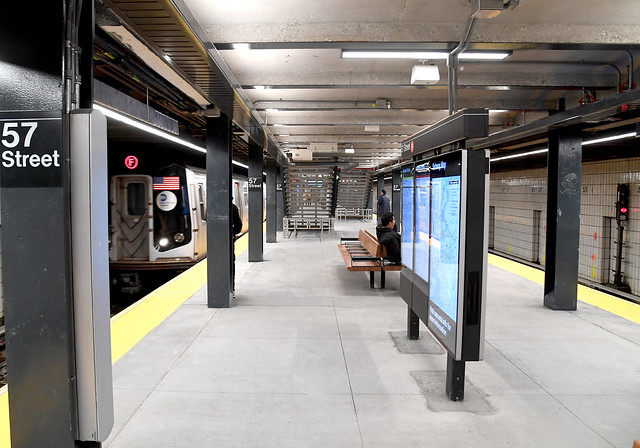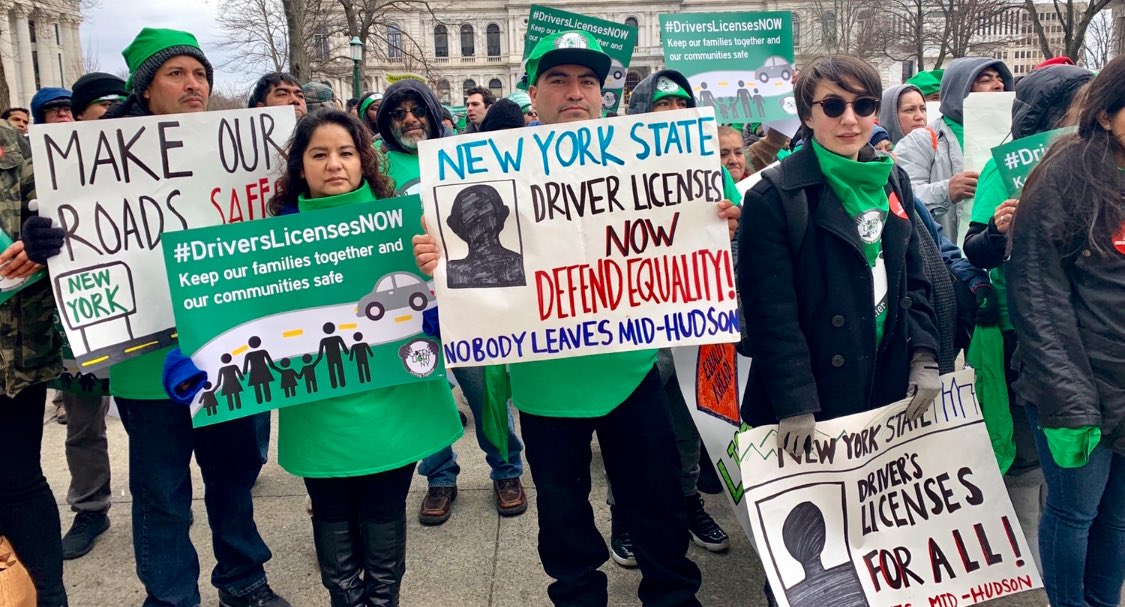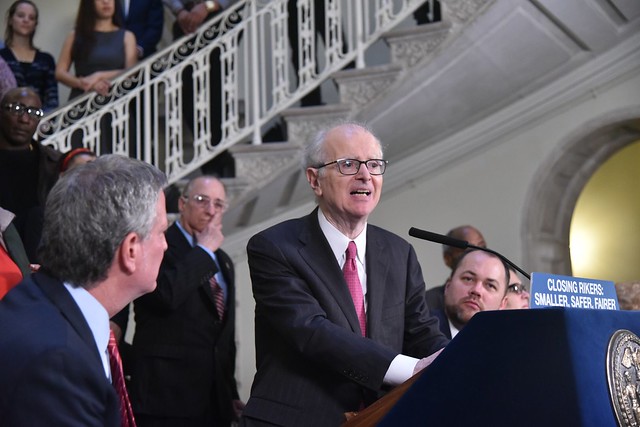Reorganizing the MTA with a Transparent, Public Process

(photo: Marc A. Hermann / MTA New York City Transit)
In advance of the MTA Board meeting taking place today (Wednesday, May 22), Reinvent Albany and ten other groups including Riders Alliance, TransitCenter, Regional Plan Association, and others sent a letter asking the Metropolitan Transportation Authority (MTA) to make sure that the process for developing its reorganization plan -- as required by this year’s state budget -- is public, transparent and consultative.
At a time when the MTA has been seeking to restore the public’s trust, it is as important as ever that a reorganization is not disruptive to riders, who are counting on a reorganization to provide better, not worse, service. Ensuring the discussions over the pending reorganization are open and consultative will help put the MTA’s best foot forward to show it is acting in the public interest -- something highlighted as a major need in Reinvent Albany’s recently-released Open MTA report.
So far, the process has not been public or transparent, and MTA Board members have raised important questions about their role. In March, before the state budget legislation was passed creating the mandate for reorganization, the Board was asked by MTA management to approve a contract with consultants AlixPartners. Once the budget was finalized and passed, at the April Board meeting, a $4 million contract was approved for AlixPartners to develop the reorganization plan.
While the law sets up milestones for the process to unfold, there is no detail on how the public is to be engaged in the process, and little detail on how the plan is to be presented to the public. The state budget requires the MTA’s consultant, now AlixPartners, to give its plan to the MTA Board by June 30 of this year. Our view is that the plan should be made public at that date, including any accompanying analyses.
AlixPartners is also conducting a “review” of waste, fraud, abuse, conflicts of interest, duplications of functions, etc., which is due to the MTA by July 31. Under law, the “review” is to be made public within 30 days of receipt by the MTA.
Best would be to make the AlixPartners “review” public as soon as it is received by the MTA Board, since there is a narrow window of time for adopting the reorganization plan. Within 90 days of receipt of this “review,” the reorganization plan is to be “updated” by the authority to incorporate its findings.
It is our understanding that the MTA Board, acting as the authority, will vote on a final reorganization plan sometime before the end of October of this year. Well before a final plan is voted on, the MTA Board and staff should reach out to public stakeholders, including riders groups, unions, advocates, and elected representatives, and publicly consult with them about potential recommendations. This would be best done outside of the MTA Board meeting process, which limits public engagement to 2-minute presentations and does not allow a dialogue to occur.
Beyond ensuring that the reorganization plan process is open and consultative, as supported by our partners, Reinvent Albany has a number of questions about the ramifications of the plan itself that we would like the MTA to answer:
- The MTA’s efforts to consolidate invoice payments, human resources, and IT functions under the Business Services Center (BSC) have not been independently evaluated, though general consensus is that the effort was rocky at first, though appears to be moving in the right direction. What has the MTA learned from this past consolidation that should apply to the current reorganization process? Reports on the BSC from MTA show that its current mandate is considerable.
- How will the plan ensure that the MTA’s professional staff are allowed to have independence, and be free from the past politicization that has plagued the MTA?
- What will be the role of agency presidents going forward? Andy Byford has hired considerable talent, including, for example, Sarah Meyer (Chief Customer Officer), and Pete Tomlin (signals technology expert). How will this staff talent be retained and used in the future?
- How will the plan ensure that there is not further brain drain, and work to boost MTA staff morale? The hiring freeze has put considerable strain on current MTA staff to already do more with fewer resources (in some cases necessitating overtime), and morale appears to be at an all time low.
- How will the state budget provision that enables sharing of employees facilitate reorganization? How will any sharing of employees be reported to the MTA Board and public? How will collective bargaining agreements affect the proposed reorganization/employee sharing?
- How will the plan address transparency and accountability? MTA CEO/Chair Pat Foye has promised to overhaul the Freedom of Information Law (FOIL) process and Open Data at MTA, yet the Information Technology (IT) department has already been consolidated, resulting in the elimination of 187 positions, in addition to the current hiring freeze.
Reinvent Albany also has concerns that this IT consolidation is creating an outsourcing trap for the MTA that results in dependency on outside, costly consultants. Transparent efficiency efforts rely on IT staff having the people, resources, and political will to make changes. Will they?
The MTA should seek to answer these questions -- and those of other stakeholders -- in a public, consultative process. MTA riders and taxpayers deserve nothing less.
***
Rachael Fauss is Senior Policy Analyst at Reinvent Albany. On Twitter @RachaelFauss & @ReinventAlbany.
***
Have an op-ed idea or submission for Gotham Gazette? Email This email address is being protected from spambots. You need JavaScript enabled to view it.
Restoring Access to Driver’s Licenses Will Make New York Roads Safer

(photo: @EddieATaveras)
As a former Suffolk county police officer and detective, I think a lot about what keeps our communities safer. And one thing I know is that our roads are safer when everyone who is driving is licensed and insured. That’s why, as a state legislator, I believe New York should let all qualified drivers, regardless of immigrant status, follow the same process to get a driver’s license.
Driving is essential on Long Island. Throughout most of our region, you need a car to get to work and to drive your child to school or the doctor. Passing the Driver's License Access and Privacy Act would mean that 265,000 New Yorkers, including 51,000 Long Islanders, who currently don’t have access to a license would be able to safely drive to carry out their basic daily life necessities.
The roads in our state will be safer because every driver will go through the same process: submit an application, take a road test, and, if you pass, obtain a license. Making sure all drivers are licensed and insured means that more drivers are aware of traffic regulations and will likely reduce traffic-related incidents.
Roads are safer when all drivers can be tested, licensed, and insured. While research has shown that undocumented immigrants are particularly careful drivers, they are even safer when they have a state issued driver’s license. Various studies have concluded that ensuring equal access to licenses can reduce the incidence of traffic fatalities. And, in California, data show that within the first year of passing a similar policy to expand access to driver’s licenses, the number of hit-and-run accidents declined.
In addition to making our roads safer, restoring access to driver’s licenses to all New Yorkers can help build trust between local law enforcement and immigrant communities – a relationship that has been crippled by a series of attacks on immigrants and people of color by the Trump administration; the president went as far as encouraging police brutality in a 2018 visit to Long Island.
In the climate of fear that Donald Trump has created, members of our communities are more fearful than ever of interactions with law enforcement, which can lead people to not report crimes that they witness or of which they are victims. This is especially true when people don’t have access to a state identification document.
No one, regardless of immigration status, should have to fear contacting a police officer, whether it is to ask for help or to contribute to a solving a crime, for lack of documentation. Having a driver’s license will lead to thousands more current New Yorkers having access to an identification document that enables them to identify themselves as they drive on the road and proceed with their daily lives.
Restoring access to driver’s licenses will also be an economic win for our state. Immigrant New Yorkers already contribute enormously to our state’s economy -- contributing more than $100 billion annually as consumers, and more than $1 billion in taxes on top of that.
If the driver’s licenses bill, which would especially increase the number of immigrants with licenses statewide, were passed, the Fiscal Policy Institute has found there would be a further gain. Annual state revenues would increase by $57 million, and there would be a $26 million one-time boost in revenue, as people obtain licenses and purchase cars.
It’s also worth noting what this bill won’t do. The standard issue licenses that would be available to undocumented people would not be valid for air travel, for entering federal government facilities, or to vote. The standard licenses would simply enable members of our communities to access the roads and the insurance they need.
The Driver's License Access and Privacy Act would bring benefits to all Long Islanders through improved road safety, trust in law enforcement, and an economic boost. New York should not delay. This should be the year to restore access to licenses to all qualified drivers.
***
Phil Ramos is an Assembly member representing New York’s 6th Assembly District in Suffolk County. On Twitter @PhilRamos6AD.
***
Have an op-ed idea or submission for Gotham Gazette? Email This email address is being protected from spambots. You need JavaScript enabled to view it.
The Next Battleground in the Fight to Close the Rikers Island Jails

Jonathan Lippman, one of the authors (photo: John McCarten/NYC Council)
The New York State Legislature recently passed a landmark suite of criminal justice reforms that will profoundly re-shape the justice system in New York. Among other things, the reforms should help recalibrate the balance of power between prosecutors and defense attorneys and accelerate the effort to close the notorious jail complex on Rikers Island.
A recent analysis found that by reducing the use of bail, the legislative reforms would result in the release of more than 40% of the defendants held in pretrial detention in New York City.
Legislative changes like these almost always generate significant public attention -- newspaper headlines, social media traffic, and the like. But if we hope to create a justice system that truly serves as an international model of fairness and effectiveness, we cannot rely solely, or even primarily, on legislation.
The kind of cultural change that is required in New York cannot simply be imposed from on high by political actors; it must be embraced by frontline practitioners – judges, attorneys, police officers, and others. These officials must be given the tools they need to both maintain public safety and ensure that every defendant and every victim is treated with dignity and respect.
This means making long-term investments in training and education – for example, teaching justice officials about the long-lasting effects of trauma among the justice-involved population. It means reshaping the physical plant of the justice system so that our police precincts and courthouses and jails are designed to welcome rather than intimidate users. And it means focusing in the trenches on boring and technical issues like the speed with which cases are processed by the justice system.
Take felony cases. New York’s court system has long expected felonies to be resolved within 180 days of an indictment. Yet, among indicted felonies resolved in 2018 in New York City, despite the herculean efforts of court administrators, cases averaged more than ten months to a resolution. Shortening this timeframe doesn't make sense just from an efficiency standpoint -- it should also help reduce the jail population in New York City, since many of these defendants are currently detained on Rikers Island while their cases are pending.
The new legislative reform should make a real difference -- most discovery becomes automatic and must be completed within 15 days of arraignment. Chief Judge Janet DiFiore has also made inroads in recent months, employing new technology, changing judicial assignments, and using her bully pulpit to make improved timeliness the top judicial priority.
And, yet, there is still enormous potential for delay within the courts. What else can be done?
Judges and attorneys can take several practical steps to make the constitutional right to a speedy trial more of an everyday reality.
For one, the parties can shrink the number of days in between each court appearance. In 2016, the Office of Court Administration endorsed a 30-day cap. As adjournment length declines, there will be less idle time waiting for the next court date.
Second, once discovery is complete, judges can make it a routine practice to convene attorneys in a case conference outside the courtroom. A conference is an opportunity to have an honest discussion about the strengths and weaknesses in each side’s case and, potentially, to reach a good faith plea agreement sooner rather than later in case proceedings.
Third, judges and attorneys can agree to formal guidelines up front that state exactly what each party is responsible for accomplishing in between each court appearance -- in lieu of constantly reassessing progress at each successive court date.
Earlier this year, the Brooklyn Supreme Court, with the cooperation of the Brooklyn District Attorney and the local defense bar, launched an experiment that seeks to move in these directions. With support from the Art for Justice Fund and the Center for Court Innovation, the parties agreed to use a case processing roadmap that clearly defines what should happen from one court appearance to the next in indicted felony cases.
The Brooklyn pilot is an attempt to implement case processing reforms recommended by both the Mayor’s Office of Criminal Justice and the Independent Commission on New York City Criminal Justice and Incarceration Reform. If successful, it can potentially serve as a model for the rest of the city.
To close the Rikers Island jails and create a better justice system is a complicated endeavor that will require sustained effort over the course of many years. Policy, at both the city and state level, has an important role to play. But so does practice.
There aren’t going to be any ticker-tape parades when felony cases are resolved four months quicker, but it is precisely these kinds of changes that are the critical next frontier in the fight for criminal justice reform in New York.
***
Jonathan Lippman is a former chief judge of New York State, of counsel at Latham & Watkins LLP, and chair of the Independent Commission on New York City Criminal Justice and Incarceration Reform. Greg Berman is Director of Center for Court Innovation.
***
Have an op-ed idea or submission for Gotham Gazette? Email This email address is being protected from spambots. You need JavaScript enabled to view it.




